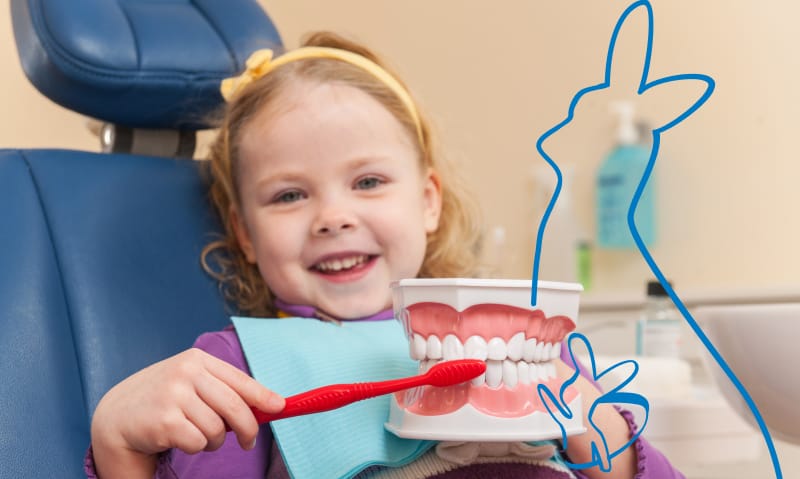Early Orthodontic Evaluation — Saving Time, Angst and Money

Remove unnecessary angst for your child by scheduling an orthodontic evaluation at age 7.
Kids face plenty of challenging experiences throughout their childhood. The ages of 7 to 11 comprise what many physicians consider middle childhood. During this time in their lives, children grow both physically and cognitively. From growth spurts to major early academic milestones, these years are full of changes. Though parents celebrate and enjoy the years, these same years can be full of angst for children.
One of the significant challenges that children face in this age group relates to the teeth. Though getting kid’s braces and straightening teeth can be considered an adolescent rite of passage by many, there are strategies to lessen these challenging times for children. Early orthodontic evaluations, starting at age 7, can help save parents with cost and create less pain and suffering, and provide a better overall experience for their child.
What to expect during your child’s early orthodontic evaluation.
Just as you likely had questions about your child’s first dental visit so many years ago, you are probably full of questions about what an early orthodontic evaluation will entail. Before we start answering those questions for you, however, we want to reiterate that you are doing the right thing for your child by scheduling this appointment sooner rather than later.
When should an early evaluation happen?
The American Association of Orthodontists suggests that children have an orthodontic evaluation by no later than age 7. One of the main reasons for this early evaluation is because all children differ in their physical and physiological development. As a result, treatment needs may vary.
Even though the checkup might indicate that your child’s bite is fine and all looks good, there is no way to know that without an assessment. Only an orthodontist or trained pediatric dentist will be able to identify the early signs of a problem. If a problem is noticed early on, it can be determined whether your child can benefit from early treatment or if it is best to wait.
Early orthodontic treatment can prevent severe problems from developing. As a result, treatment may be shorter and less complicated than it would be in later years. The added benefit is that your child may be able to avoid some of the teenage angst that comes with braces and orthodontia during the adolescent years.
The Benefits of Early Orthodontic Evaluation
Early orthodontic intervention can result in the following benefits.
- Correct harmful oral habits
- Guide permanent teeth into a more favorable and aesthetically pleasing position
- Guide jaw growth
- Lower the risk of future trauma resulting from protruded front teeth
- Improve the way the lips meet
What does the early evaluation exam look for?
During the exam, your kid’s dentist will look for buck teeth, deep bites, underbites, open bites, crowding, and crossbites.
- Buck teeth—Also referred to as an overbite, buck teeth happen when the front upper teeth protrude out on top of the lower teeth.
- Deep bite—A deep bite is a misalignment of the teeth when the top front teeth overlap the bottom teeth. This is also commonly referred to as an overbite or a closed bite.
- Underbite—An underbite is the opposite of an overbite in that it happens when the lower front teeth are in front of the upper teeth when the mouth is closed. In this case, the problem is caused because the jaw is positioned too far forward.
- Open bite—An open bite is just what it sounds like. With this malocclusion, there is no vertical overlap between the top and bottom front teeth. There is a gap when the person closes their mouth and teeth together.
- Dental crowding—Dental crowding happens when there is not enough space for all of the teeth to fit within the jaws. This can result in rotated or displaced teeth.
- Crossbite—Crossbites occur when some of the upper teeth sit inside the lower teeth (rather than on the outside) when the child’s mouth is closed.
What is dental misalignment?
Suppose you are like many parents and are trying to understand more about what to expect in your child’s early orthodontic evaluation. In that case, you probably see the term misalignment and malocclusion used frequently. The primary goal of this orthodontic assessment is to determine if any type of misalignment exists. With early intervention, it is possible to identify urgent issues that could impact growth and development. Early intervention is all about prevention.
Malocclusions are typically associated with physical and psychological issues that can lead to self-consciousness and lowered self-esteem. When not corrected promptly, these dental misalignments can affect a child’s speech by causing a lisp, interfere with the proper chewing of food, and cause challenges with adequate brushing or flossing, thus increasing the chances of tooth decay, gingivitis, and bacterial infection.
Ready to schedule your child’s early orthodontic evaluation?
We highly encourage parents to schedule their child’s early orthodontic evaluation around the age of 7. But even if 7 has come and gone, it is never too late. Your Rochester dentist will be happy to see your child and work with you on the best treatment options should a malocclusion be identified.
If you are ready to schedule an appointment or have questions for your family dentistry expert, give Dr. Shea’s office a call at (585) 247-6230. Or, email us at staff@JudithSheaDDS.com. We’re here and ready to help answer your questions.